Those of you hardy enough to stick with me here have read of our travel adventures in the Southwest, Midwest, and Plains since our family moved to Denver in 2017. Among other long-weekend destinations, we’ve visited Santa Fe; the Black Hills of South Dakota; various destinations in southern Utah and the Four Corners; and most recently, Aspen, Colorado for peak fall color. (No write-up on that one, yet!) Our daughter was recently in town for fall break, and we decided to return to Moab, Utah, to re-visit Arches National Park, and to hike the Fiery Furnace again.
Moab has become one of our favorite places to visit. Five and a half hours from our doorstep, in southeastern Utah, Moab sits at the southern tip of Arches National Park, along the Colorado River. This was my second trip, and my wife’s third. Daughter has never visited, so off we went for a 36-hour weekend jaunt. It is a wonderfully stark desert landscape of red-hued sandstone, a segue from the mountains of Colorado into the “true” southwest of New Mexico, Arizona, and Nevada. Moab is a prime recreational destination for hikers, mountain bikers, and off-road riders.
The drive to Moab is itself something to experience. Starting in Denver, sitting on the western Great Plains with the Rockies in view, one travels west along I-70, soon crossing the Continental Divide through Eisenhower Tunnel. At 11,000+ feet elevation, it’s the highest tunnel in the Interstate Highway system. Emerging from the far side of it, you soon pass Breckinridge and Vail, which anchor the busiest cluster of ski resorts in the Colorado Rockies.
Continuing west, the terrain is still mountainous, but the peaks are lower, softer, and browner. The evergreens of the national forests east of Vail give way to a low scrub as you enter the arid Western Slope of Colorado, whose gateway is Glenwood Springs. Here, I-70 squeezes itself through a rocky gorge along the Colorado River. This was one of the last segments of the Interstate Highway system to be completed, and herculean feats of engineering were required to build a road through the close confines of the gorge.
For much of its course in Colorado, I-70 parallels the Colorado River. But beyond Glenwood Springs, the road and river separate, with the Colorado meandering on a more southwesterly course, to cut across Utah’s southeastern corner on its way to Arizona, and beyond; while I-70 continues almost due west to its termination in western Utah at I-15, that state’s main north-south artery. To get to Moab, you continue westward, exiting I-70 onto US 191 about forty miles inside Utah. 191 heads due south, skirting Arches to its west, and meets up with the Colorado at Moab. So Moab sits at the southern apex of a rough equilateral triangle formed by I-70 on the north, US 191 on the west, and the Colorado River on the east.
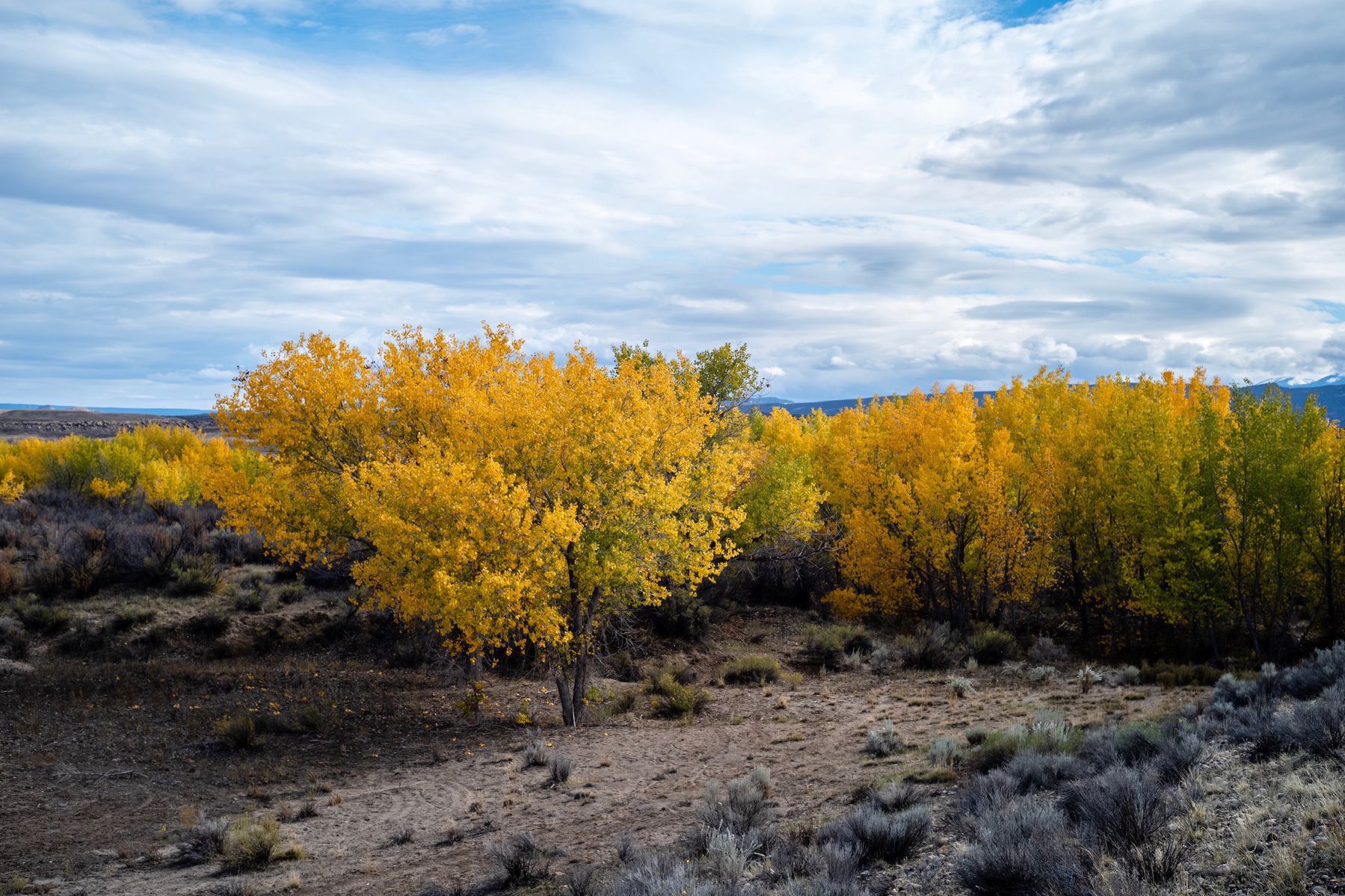
We stayed again where we have before, at Red Cliffs Lodge, a rustic resort on the river, a half hour from Arches. It’s serene and beautiful; highly recommended. We got to town in late afternoon, in time to check in and drive to Arches to look around.
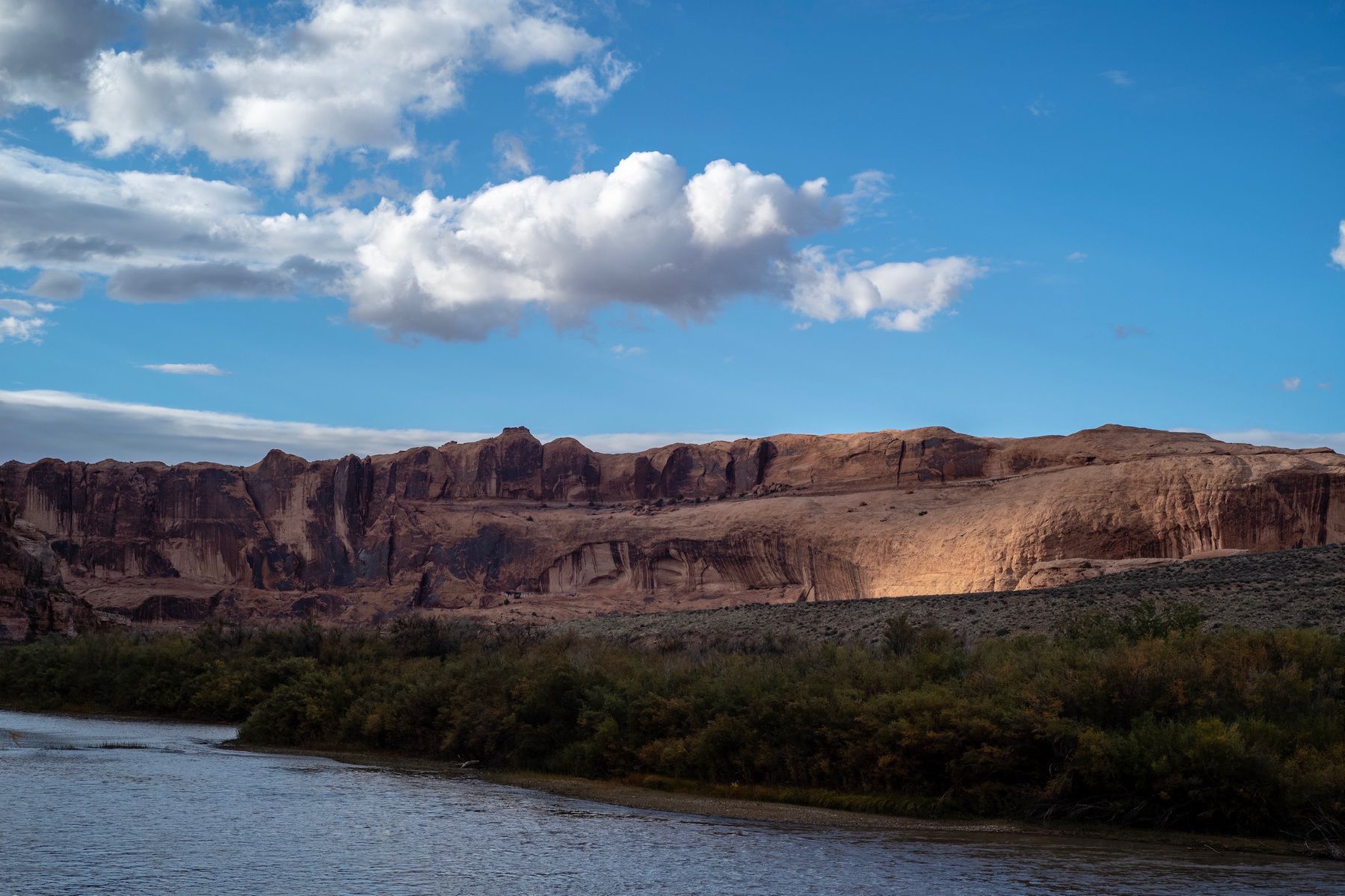
There was no one at the entry pavilion to take our admissions fee, and the visitor center was closed, so we drove the road that rings the park, taking in the late-afternoon light and then the sunset as it played across the red sandstone arches that give the park its name. This is the Golden Hour of which photographers speak rapturously; the sun has dipped below the horizon, and the landscape is illuminated only by the sky itself. From there it was back to the lodge for an early dinner and lights out.
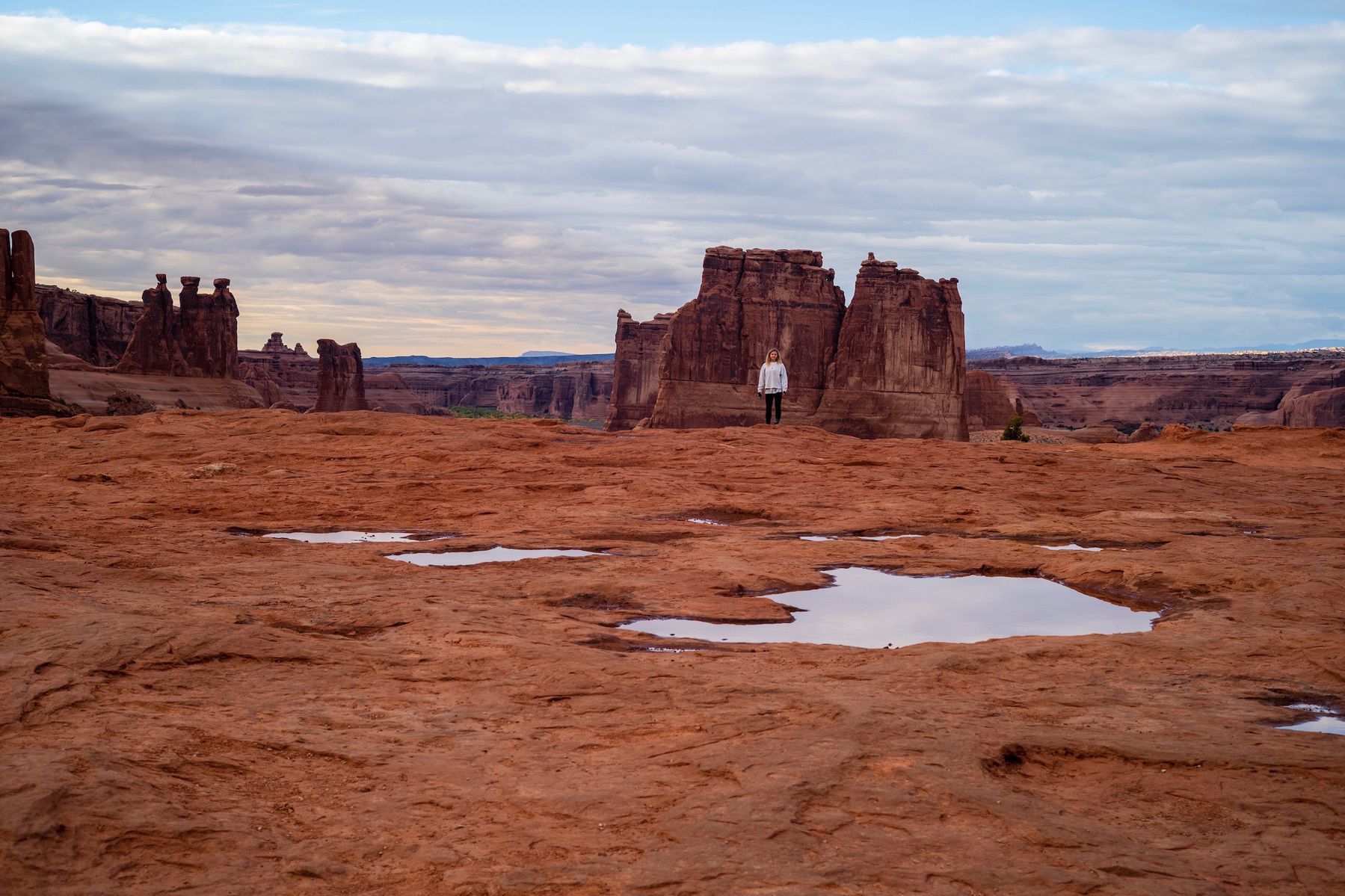
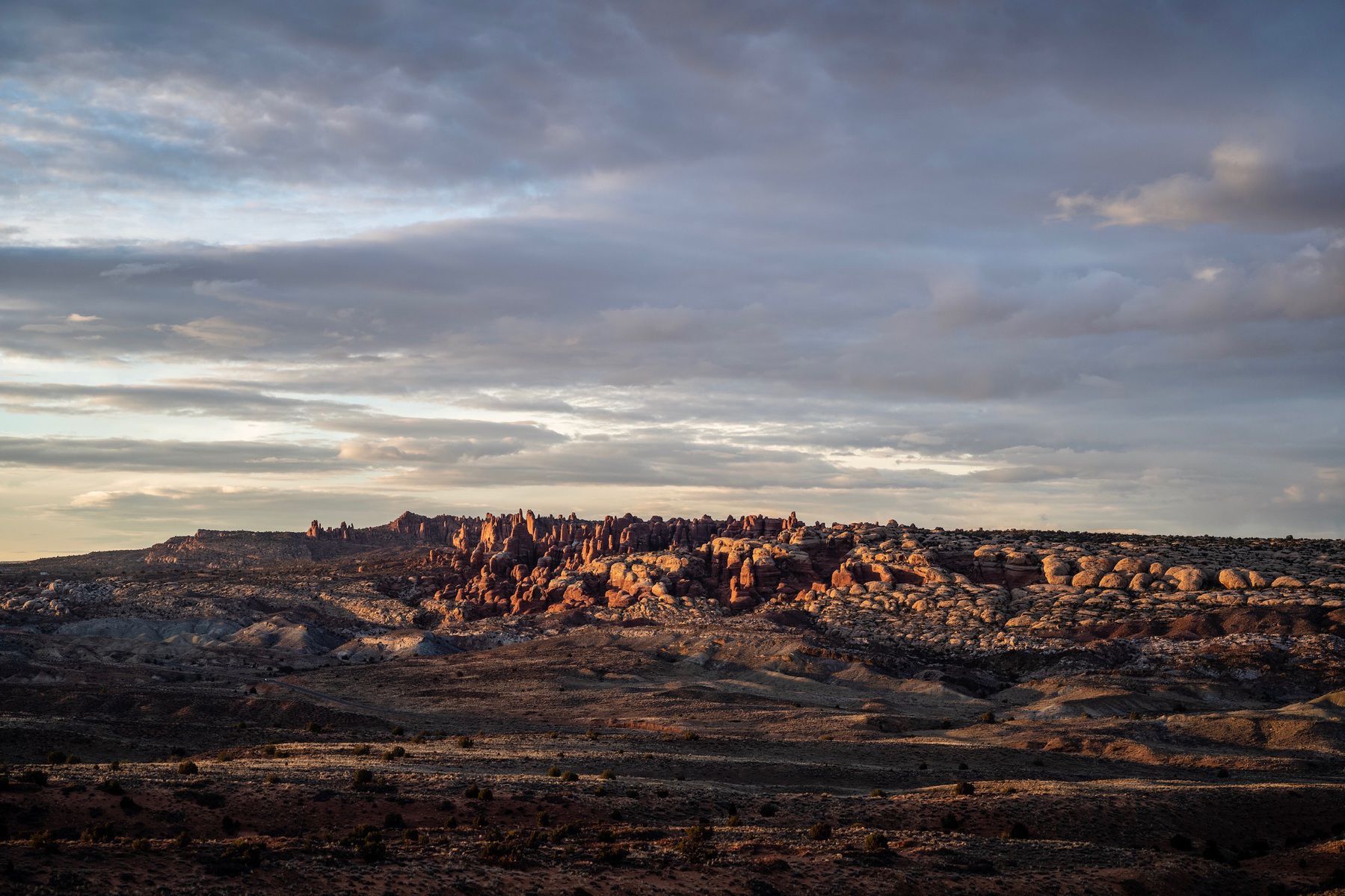
We left before dawn and got to the park just as it was getting light. This is another Golden Hour, when the sky is bright but the sun hasn’t yet shown its face to the east. We again drove the ring road, and walked among the arches to make a few pictures. By this point the tour buses had begun to disgorge their hordes of passengers, none of whom had gotten the memo that the park’s majestic splendor might best be enjoyed in reverent silence. We departed to the staccato hammering of DSLR shutters, cameras borne by the wrinkled necks of codgers not much older than myself.
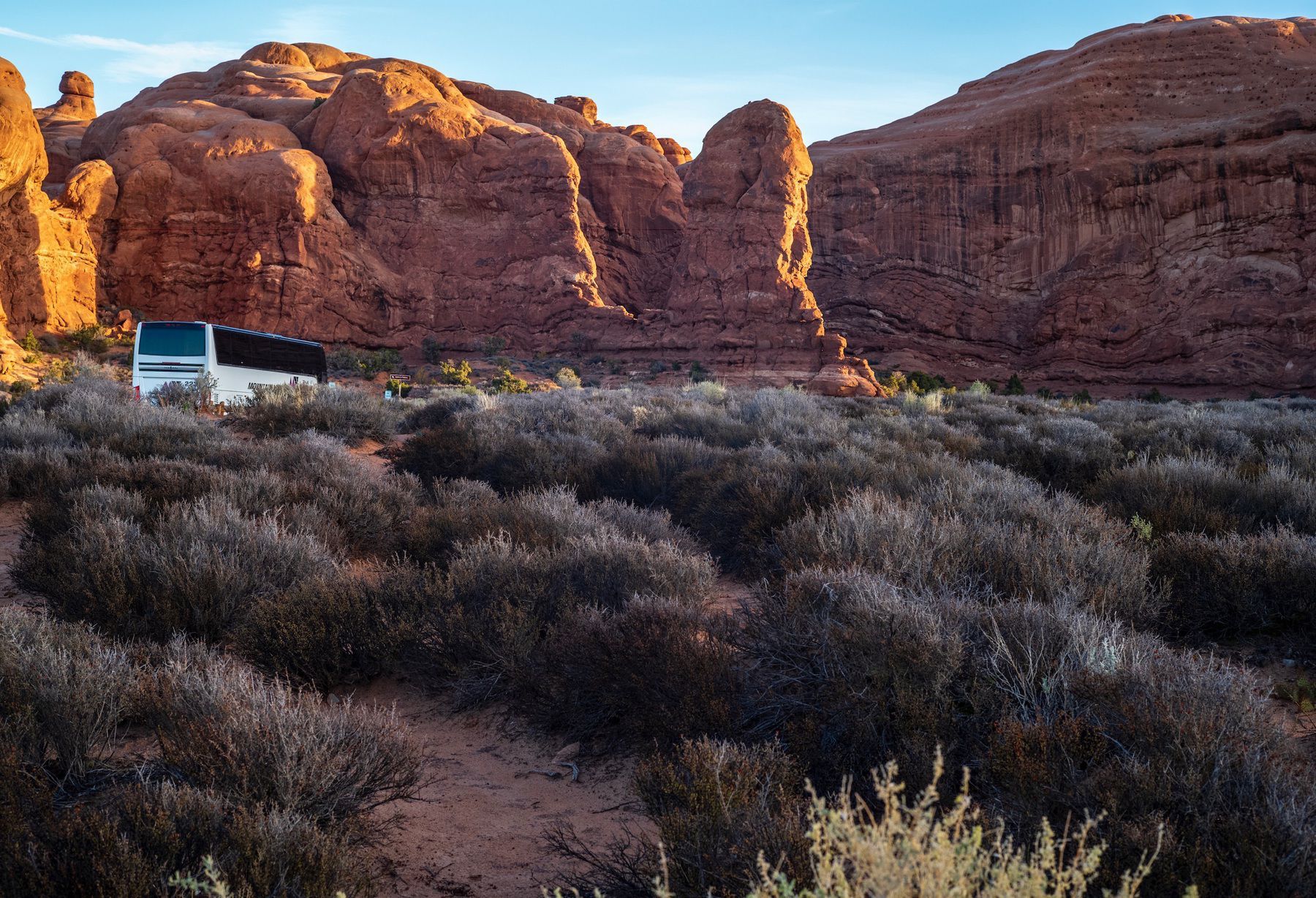
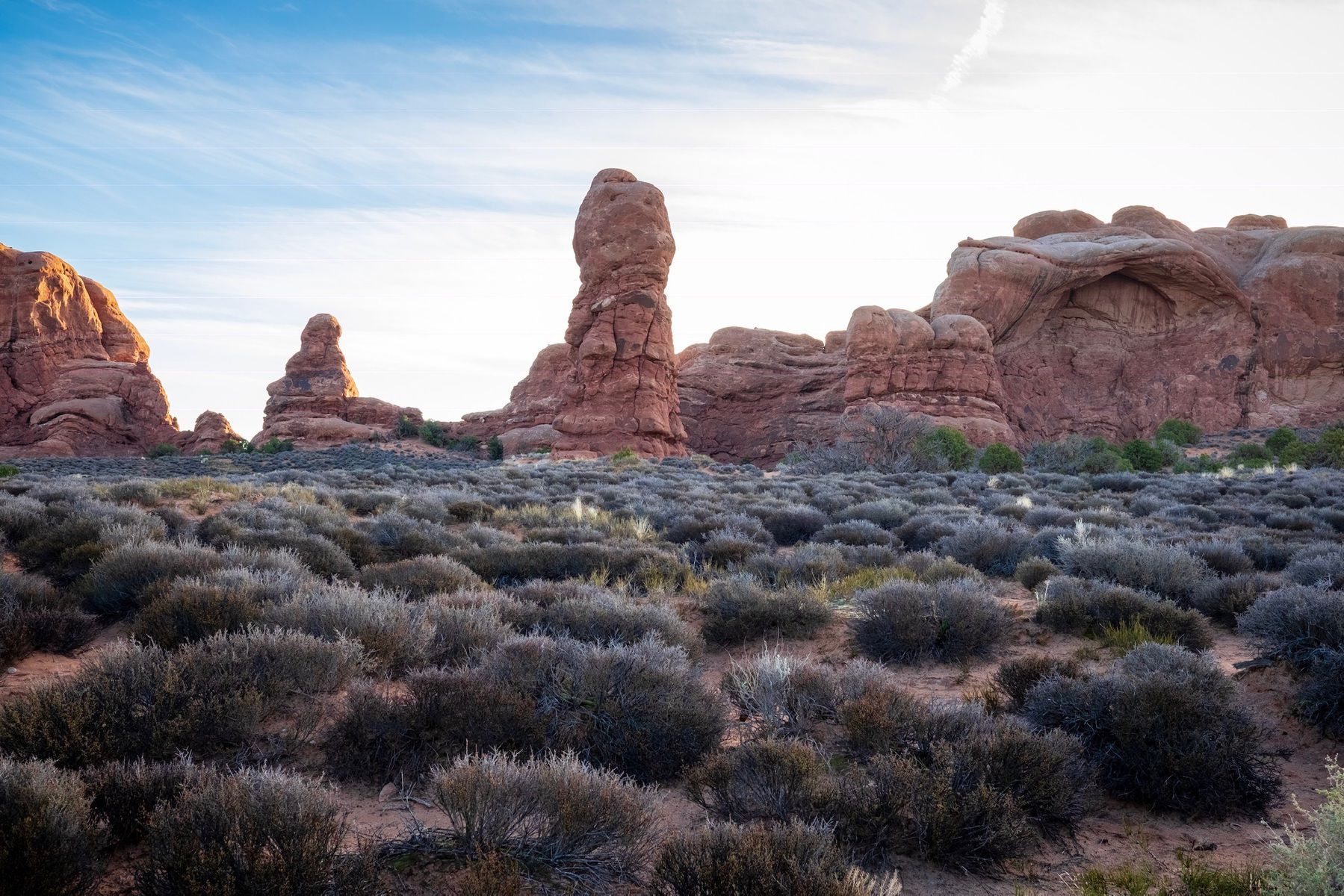
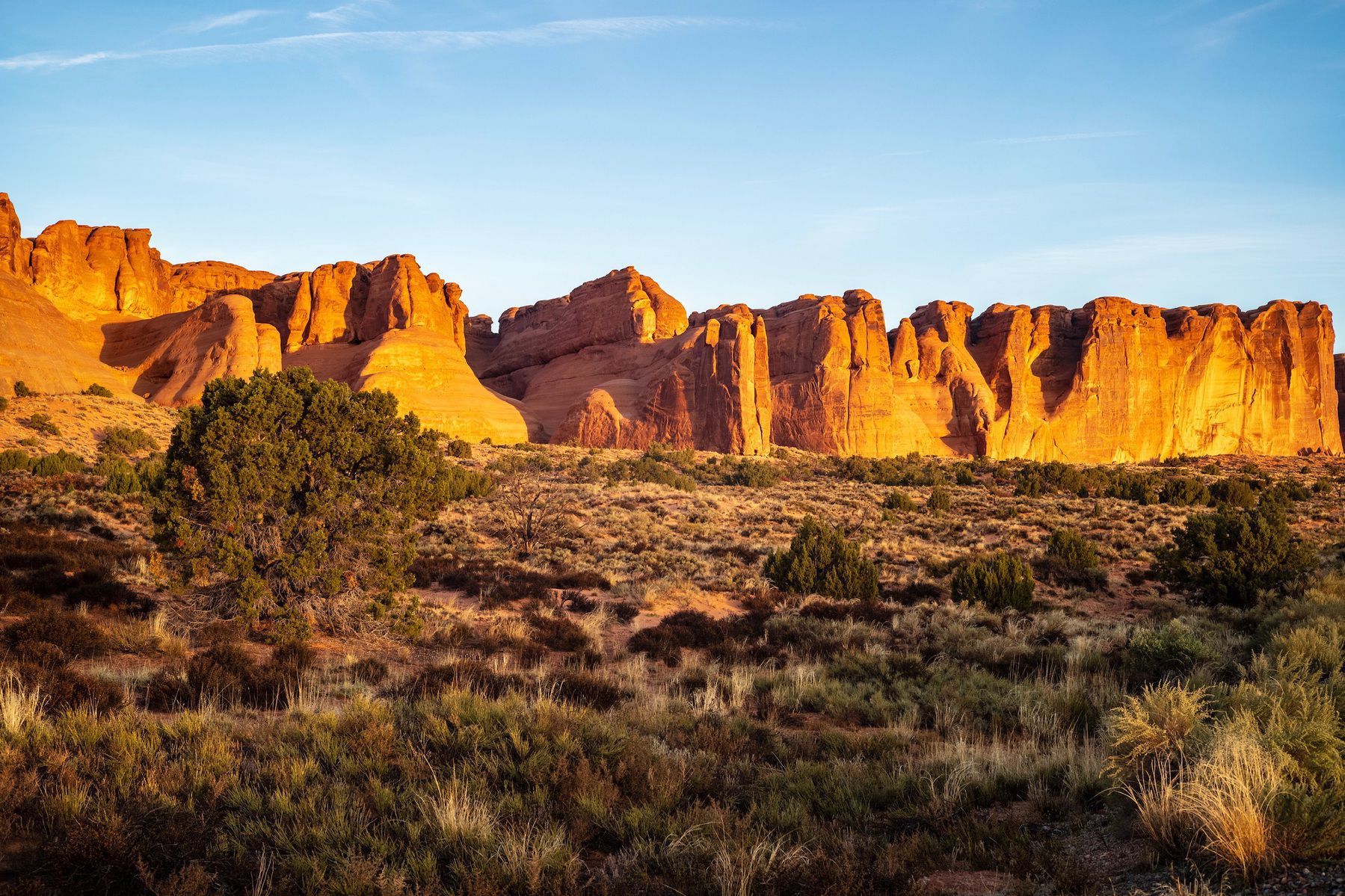
We made it to the Visitor Center just after it opened, to find out that all but a dozen of the daily allotment of fifty Fiery Furnace passes had been sold. Snooze You Lose, indeed. Passes can only be picked up in person; there’s no online ordering, and you can’t get them more than seven days in advance. We paid our money and watched the orientation video, topped up our water containers, and left for the Furnace with our Camelbacks sloshing in our packs.
The Fiery Furnace is a labyrinth of flame-colored sandstone spires and blade-like walls, carved by water erosion over eons from the sedimentary rock of an ancient sea that once covered the region. There are many narrow passageways to squeeze through, and a lot of clambering over rocks. It’s not that hard a hike, but a reasonable level of fitness and strength are required to manage it.
We’d last hiked the Furnace in September 2017 with friends, en route to their place in Park City, Utah. That day it was 100ºF-plus in the Furnace, with scarcely a breath of wind, and the mid-day sun blow-torching the rocks. We felt like onions being caramelized in a giant skillet. We hadn’t brought enough water, a mistake we vowed not to repeat this trip. We’d struggled to find our way along the counterclockwise “trail” that’s marked out for us middle-aged tenderfeet by dun-colored arrows siliconed to the rock, pointing you to the next turn. They are kept unobtrusive in order to preserve the Furnace’s feel of solitude and wild-ness, but last September we could have used a bit more “obtrusion”. We got seriously turned around, and dehydrated, before figuring things out and making our exit. At only fifty passes issued per day, there’s no conga line of hikers to follow to the exit. You might not see another person for a couple of hours.
This time, only a month later in the year than our last trip, it was never hotter than the 70’s in the Furnace, and we had plenty of water. The trail was better marked this time, though you still had to look to find the arrows. We made it in just under four hours, under a cloudless blue sky, gazing in awe over amazing vistas. My knees and hips let me know of their displeasure; my daughter, on the other hand, scampered through the place like a mountain goat on meth.
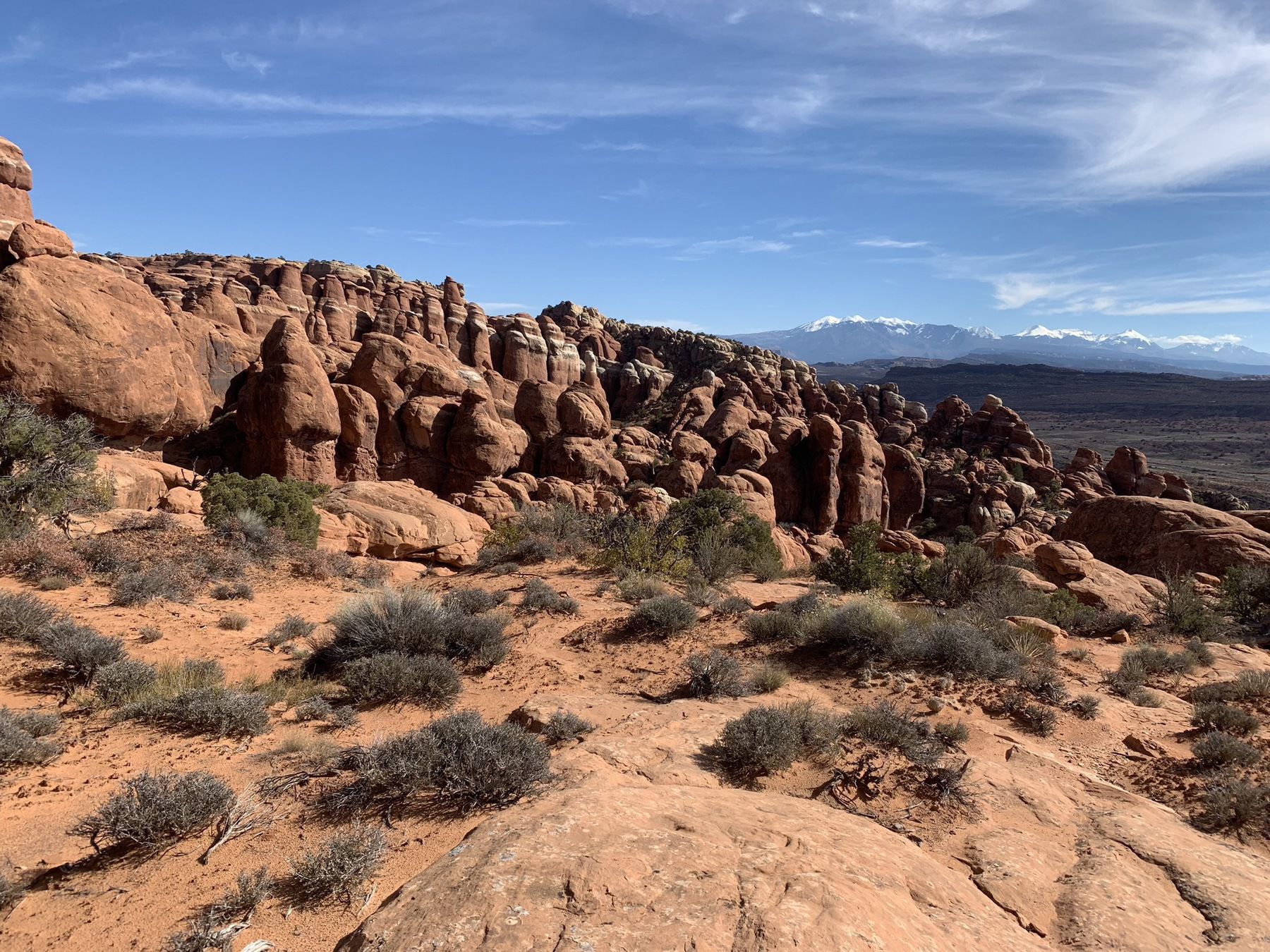
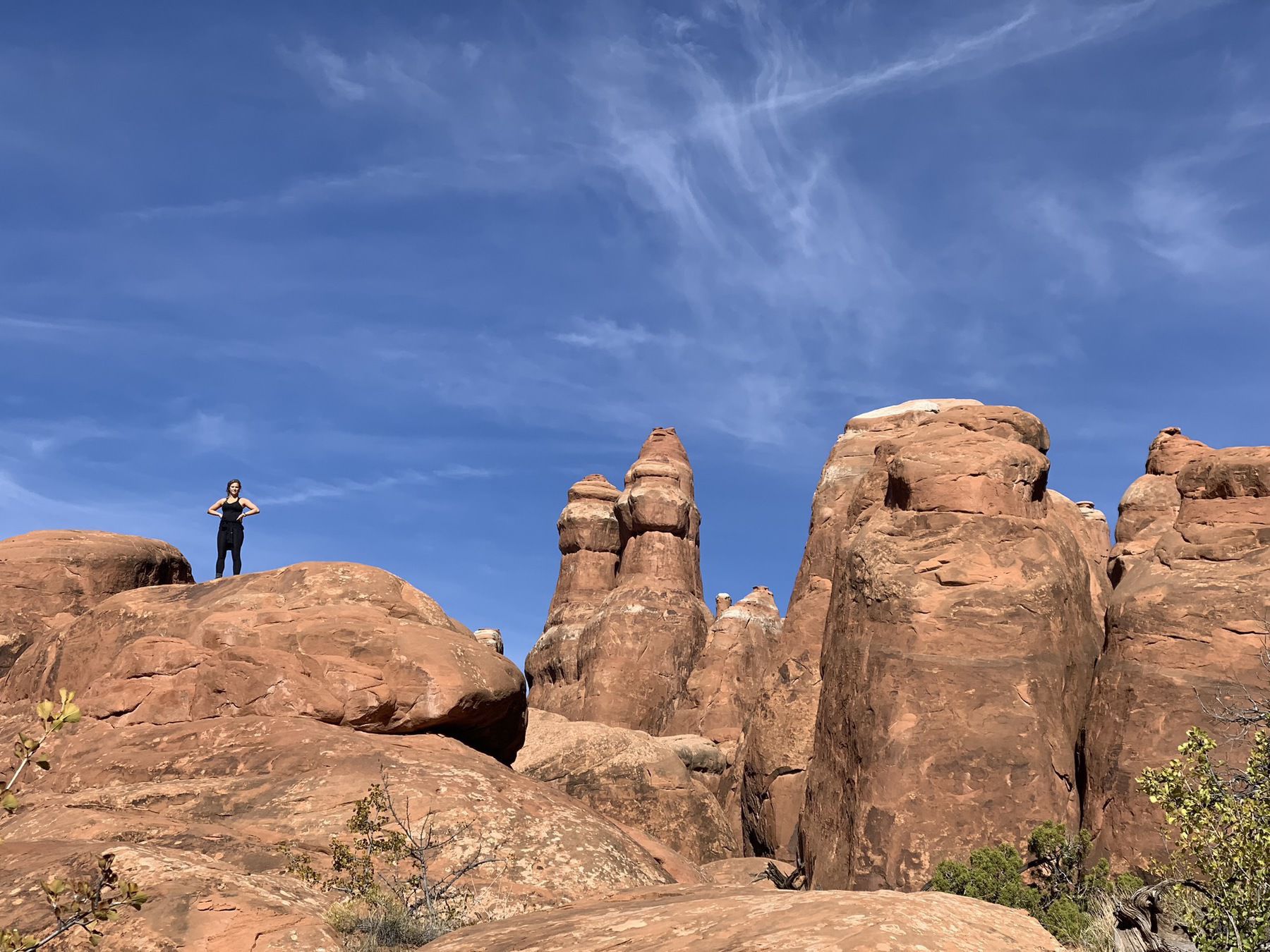
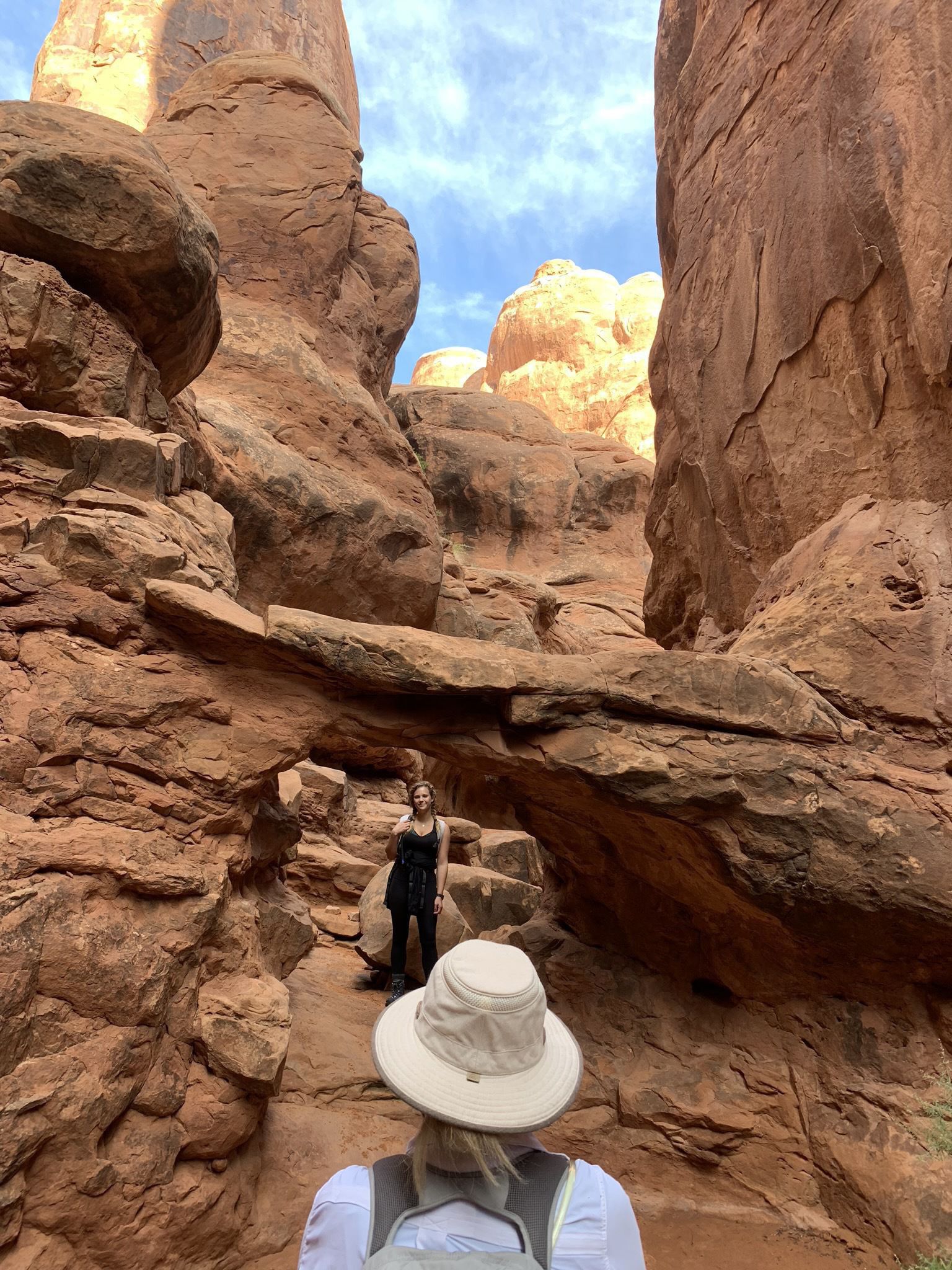
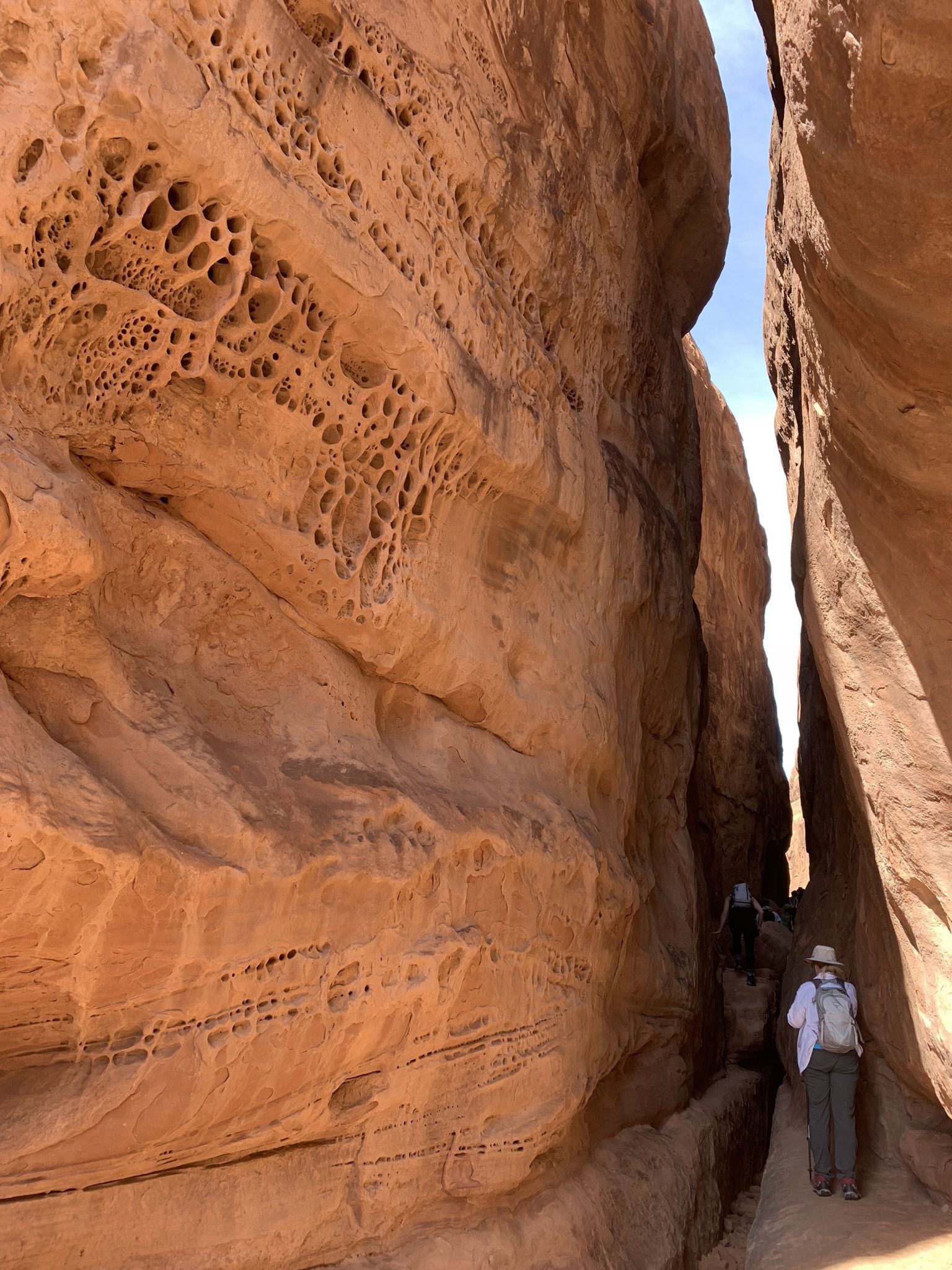
We headed, weary, into Moab for a late lunch, and pointed the car east to Denver and home.
Now for some observations on what worked photographically this trip.
This was the travel debut of my new-to-me Leica M10. After holding out for years, I’m transitioning to a nearly-all-digital photographic future. I traded a Hasselblad 203 medium-format film kit, and an “obsolete” Pentax 645D digital medium-format kit, and a few other bits and bobs from my vast hoard of photographic gear, toward a like-new M10, just as its successor M10-P was released. I care nothing about the M10-P’s touch screen or supposedly-quieter shutter; the M10 is plenty quiet for me. This one was a demo, came with a full warranty, and was priced to move. It’s the first full-frame digital camera I’ve owned; I’ve otherwise stuck with APS-C, or flirted with 44 × 33 mm “medium format” sensors.
I already have a Leica 3-lens setup — Summicrons 35-50-75 — for shooting with my M6. This trip I used the 50mm f/2 exclusively; the 35 would have been mostly too wide for the huge landscapes we surveyed. That’s one of my gripes about wide-angle lenses; many photographers don’t realize they are best used for shooting close to the subject, not for filling the frame with a massive amount of stuff from far away. Thus do I reveal my bias — photography is about selection and exclusion, unless one is simply taking mapping shots, like a cerebrate Google Street View camera.
A rangefinder like the M10 does not strike most photographers as the “ideal” kit for shooting landscapes. For me it’s ideal for shooting just about everything else, and it’s what I had, so I used it and was well-satisfied with the results. The older I get, the more I appreciate compact-and-light; I’m tired of schlepping shipping-containers of gear around. More importantly, I can actually manage to focus a rangefinder camera, whereas I find it increasingly difficult to manually focus a DSLR or medium-format camera with the usual ground-glass focusing screen. I hated to get rid of the Hasselblad and those lovely lenses; but when one shoots film it’s annoying and expensive to have only 6-8 of 12 images on the roll come out in focus. (Yes, the camera was properly calibrated, and I had an Acute Matte screen. Several, in fact.)
Why not just go with an auto-focus camera? I have one of the Fuji X-series cameras, which I also shot on this trip. It’s an excellent camera and the lenses are fantastic. (I did keep a 23mm lens on the Fuji, equivalent on its APS-C chip to a 35mm for the Leica’s full-frame sensor, for when a slightly wider viewpoint was appropriate.) I have nothing against auto-focus, but I like manual focus, and only rarely miss having auto-focus for the mostly-static stuff I shoot. And I can get by with hyperfocal “zone” focusing for all other situations: pick an aperture, say f/8 (the sweet spot for my lenses), and set the infinity mark just inside the f/8 depth-of-focus line inscribed on the lens barrel. With the 50, that means everything from 3 or 4 m to the horizon will be in focus. Just like photographers did it for the 150 years before auto-focus.
I didn’t take the Leica into the Furnace, because I didn’t want it banging off every rock I had to climb over, nor scraping against every tight spot I had to squeeze through. It would have had to go into a padded case, which I didn’t feel like carrying, or be swaddled in a Domke Wrap in my pack, to be dragged out for every shot. Those of you photographers who travel with non-photographers know how well this laborious process would have been received by your hiking companions.
The iPhone, however, is made for such missions. We just upgraded to the XsMax, and its camera is superior to probably the first four digital cameras I owned in the late 90’s and early 00’s. Mine lives in a rugged case, since I drop it onto concrete floors at least twice a day. It fits in my pocket, is easily deployed, and the images are stellar. That worked nicely.
As for my digital transition, why a “nearly -all-digital” future? Because, dang it, I just love old film cameras, enough to put up with their quirks and the aggravations of the film workflow to use them. My Rolleiflex 2.8F stays, because its lens is stunning and it’s an old-school joy to use. I hope to have it back from overhaul by the end of the year. The Fuji GF670 folder stays, because it’s a rangefinder, it folds to compact size, the lens is great, and it’s quirky and unusual. The RZ67 and the 110 f/2 stay, because they are almost too valueless to bother with selling, and that combo is great for formal portraits, and its screen is one I can focus on because it’s that good. Plus, I have a crap-ton of Fuji instant film to use up, and a couple of RZ Polaroid back to shoot it in.
The 4x5 field camera and Mamiya TLR? Jury’s still out on those. Ditto the M6, which I only just bought in the spring. Just not sure what place I have for 35mm film, when almost any decent digital sensor bests its image quality in all the ways that can be measured. At some point I’m either going to have to cull the photographic-gear herd, or rent a storage cubicle, or get a bigger house.